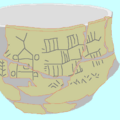Transport facts for kids
Transport, or transportation, is moving people or things from one place to another place. Transport can be divided into infrastructure, vehicles and operations.
Infrastructure includes roads, railways, airports, canals and pipelines. The infrastructure is the network where things are carried. Infrastructure also includes airports, railway stations, bus stations and seaports (docks). Infrastructure is usually built by governments and paid for by taxes from the citizens of a country or region. Infrastructure such as roads and railways are designed by civil engineers and urban planners.
Vehicles or vessels travel on the infrastructure. Vehicles include cars, trucks, trains and airplanes. Vehicles are usually designed by mechanical engineers. Vessels include boats, ferries, and barges which travel on canals and use docks and seaports. In the same way that trains use train stations, airplanes use airports. In the same way that trains use railway lines (train tracks), airplanes use flight paths and then fly in the sky.
Operations control the system. Operations include traffic signals, railway signals and air traffic control. Operations also include the government policies (a policy is a plan of action to guide decisions and actions) and regulations (a set or group of laws and rules) used to control the system, such as tolls, fuel taxes, and traffic laws.
Contents
Transport and communications
Transport and communication can be used instead of each other (someone could telephone a person rather than visit them). Transport traffic also needs communication. For example, air traffic control lets more airplanes fly. So, an increase of either transport or communication usually leads to an increase in the other one.
Transport, energy, and the environment
Transport uses a lot of energy. Most transport uses hydrocarbons (oil and gas). This can create pollution. Environmental regulations (laws) and low-pollution fuels (for example liquified natural gas) can reduce pollution. But as more vehicles are used, more pollution is created. Ethanol and biodiesel pollute less than petroleum.
Kinds of transportation
Transport can be by land, water or air:
- Land transport using walking, roads and railway tracks by bicycles and other vehicles
- Water transport using ships and barges in canals and in rivers and seas
- Air transportation using airplanes and airports and helicopters
Images for kids
-
An Air France A380 on approach to Washington Dulles International Airport
-
An Air France Airbus A318 lands at London Heathrow Airport.
-
Intercity Express, a German high-speed passenger train
-
The Harbor Freeway is often heavily congested at rush hour in Downtown Los Angeles.
-
Automobile ferry in Croatia
-
A Fiat Uno in 2018
-
Incheon International Airport, South Korea
-
Freight train with shipping containers in the United Kingdom
-
Transport is a key component of growth and globalization, such as in Seattle, Washington, United States.
-
The engineering of this roundabout in Bristol, United Kingdom, attempts to make traffic flow free-moving.
-
Traffic congestion persists in São Paulo, Brazil, despite the no-drive days based on license numbers.
-
Bronocice pot with the earliest known image of a wheeled vehicle in the world, found in Poland
-
The Wright brothers' first flight in 1903
See also
 In Spanish: Transporte para niños
In Spanish: Transporte para niños



















